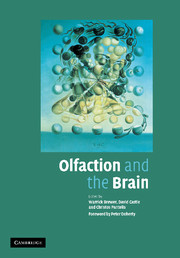Book contents
- Frontmatter
- Contents
- Foreword
- Preface
- List of Contributors
- Section I Neurology, Neurophysiology and Neuropsychology: Olfactory Clues to Brain Development and Disorder
- Section II Social Functioning: Role of Evolution, Genetics and Gender
- 8 Primate Olfaction: Anatomy and Evolution
- 9 Genetics and Family Influences on Olfaction: A Focus in Schizophrenia
- 10 Sex Differences and Olfactory Function
- 11 The Role of Pheromones and Chemistry: Lessons from Comparative Anatomy
- 12 The Impact of Olfaction on Human Social Functioning
- Section III Assessment and Disorders of Olfaction
- Index
- Plate section
- References
12 - The Impact of Olfaction on Human Social Functioning
from Section II - Social Functioning: Role of Evolution, Genetics and Gender
Published online by Cambridge University Press: 17 August 2009
- Frontmatter
- Contents
- Foreword
- Preface
- List of Contributors
- Section I Neurology, Neurophysiology and Neuropsychology: Olfactory Clues to Brain Development and Disorder
- Section II Social Functioning: Role of Evolution, Genetics and Gender
- 8 Primate Olfaction: Anatomy and Evolution
- 9 Genetics and Family Influences on Olfaction: A Focus in Schizophrenia
- 10 Sex Differences and Olfactory Function
- 11 The Role of Pheromones and Chemistry: Lessons from Comparative Anatomy
- 12 The Impact of Olfaction on Human Social Functioning
- Section III Assessment and Disorders of Olfaction
- Index
- Plate section
- References
Summary
Introduction
Social functioning is key to survival and reproduction across species, as it enables the recognition of self, kin, social status, danger and potential mates. For most mammals, social hierarchy and territory are recognised by odour, and smell plays a key role in identifying conspecifics and enemies, and determining safety from danger. The brain circuitry involved in emotional processing and olfactory function is overlapping, and among sensory modalities, olfaction is unique in that it has direct input to the prefrontal cortex as detailed in Chapter 1. This chapter relates the neurobiology of olfactory processing to social functioning in humans, with a focus on schizophrenia to highlight our understanding of compromise of these processes.
In mammals, social functioning is essential for reproduction and survival, and therefore the neural circuitry and hormonal mechanisms underlying social function are likely to be highly conserved across species (see Insel & Fernald, 2004). Although research on the significance of human olfaction and social communication is nascent, smell is known to play a role in mating, parenting, affiliation and prey–predator relationships in other mammals and it is reasonable to expect an association of the olfactory processing system with social functioning in humans as well. Nonetheless, primates in general (and humans in particular) have decreased olfactory acuity compared to rodents and canine species. Over evolution, as humans developed language and other cognitive processes for socialisation, the selective pressure to maintain olfactory genes for survival and social function was reduced and loss-of-function mutations accumulated in olfactory receptor (OR) genes (Rouquier et al. 2000).
Keywords
- Type
- Chapter
- Information
- Olfaction and the Brain , pp. 220 - 232Publisher: Cambridge University PressPrint publication year: 2006
References
- 2
- Cited by

